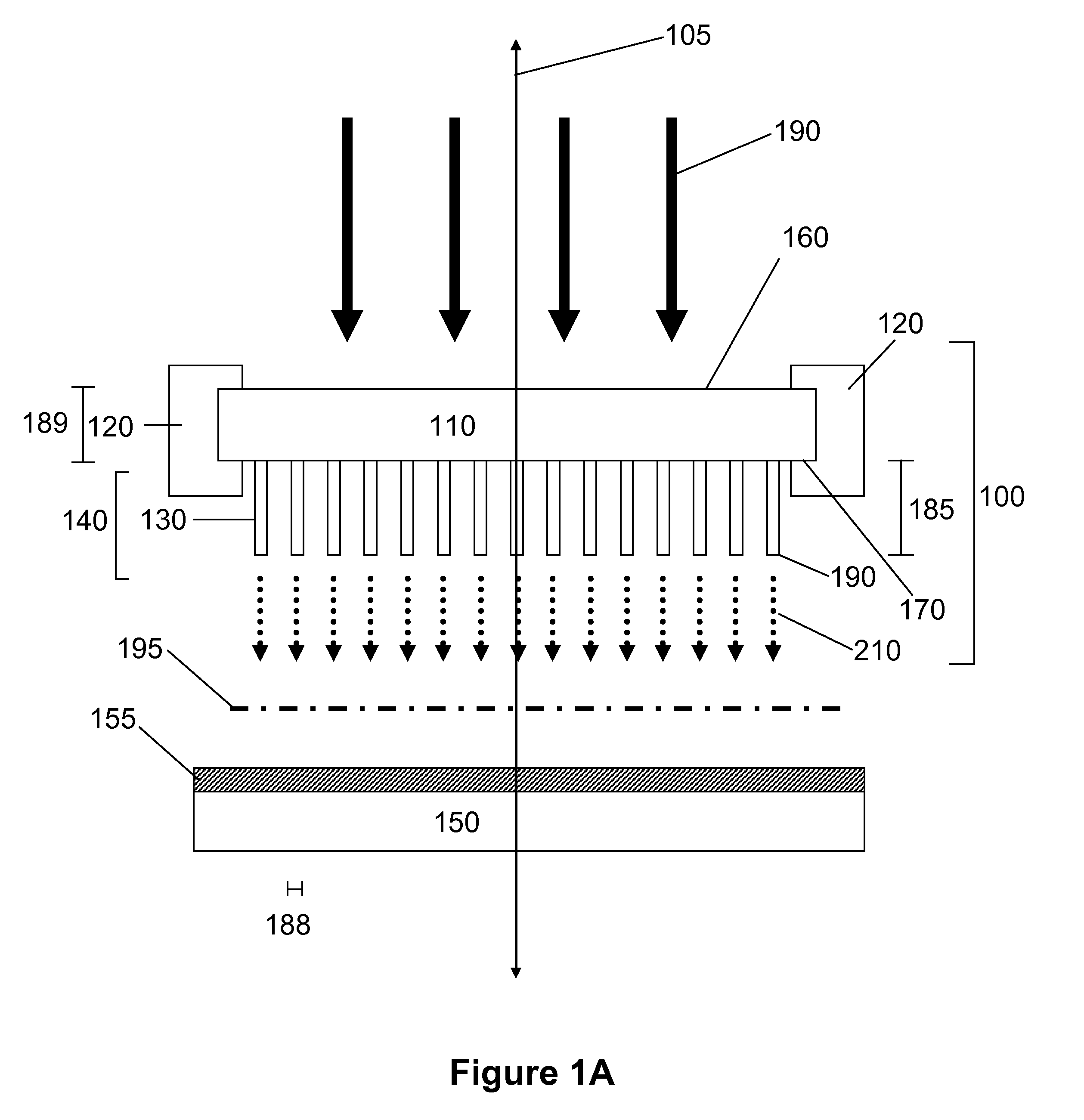Nanopillar arrays for electron emission
a technology of electron emission and nanopillars, which is applied in the field of nanopillar arrays for electron emission, can solve the problems of complete loss of gain functionality, inability to integrate a thin semiconductor membrane as a secondary electron emission element in a detector, and inability to achieve a high gain by integrating multiple stacks, etc., and achieves the effect of low cost and heavy us
- Summary
- Abstract
- Description
- Claims
- Application Information
AI Technical Summary
Benefits of technology
Problems solved by technology
Method used
Image
Examples
example 1
Nanopillar Arrays on Semiconductor Membranes Amplify Electron Emission
[0071]The present invention provides secondary electron emission devices useful for modulating incident radiation. To evaluate capability of devices of the present invention for generating secondary electron emission, a secondary electron emission device comprising a semiconductor membrane having a nanopillar array was fabricated and exposed to a beam of incident electrons. In this Example experimental results are provided relating to nano-structured single-crystal silicon membranes as the basic element for a new class of active thin-membrane detectors. This integrates the required ‘window’ with the actual detector and thus creates a detector window with gain. As described in this Example, we found that patterning a two-dimensional (2D) membrane with a regular array of one-dimensional (1D) nanopillars strongly enhances SEE generation enabling important applications such as a directed charge amplifier. Further, the...
example 2
Incorporation of a Gaseous Medium within the Nanopillar Arrays
[0084]In some embodiments of the present invention, additional gain in signal is realized by operating the nanopillar array with selected gases, such as a mixture of gases such as Ar, Ne, He, N2, O2, CO2, and CH4 gases, encapsulated between the nanopillar side of the membrane and the collection anode / Faraday cup. In this device configuration, the electrons emitted by the nanopillars are accelerated by the potential difference between the collector and the nanopillar array provided in electrical contact with the internal surface of the semiconductor membrane. If the voltage is adjusted such that the electric field in this region reaches a threshold magnitude, for example 100 kV / cm for a mixture of Ar and CH4 gases, a single electron emerging from a pillar will acquire enough energy to ionize the gas and start an electron cascade, resulting in the generation of 104 to 105 electrons. Embodiments of this aspect of the present...
example 3
Secondary Electron Generation Using an Embedded N P Junction Structure
[0085]The present invention includes electron emission devices having an array of nanopillars comprising embedded N P junction structures. To evaluate the capabilities of nanopillars having embedded N P junction structures, a semiconductor membrane made of silicon and silicon oxide embedded N P junctions was fabricated and exposed to a source of electrons. The results of this Example demonstrate that embedded N P junctions provide useful structures for generating secondary electron emission and field emission.
[0086]Conventional electron multipliers typically have many cascade stages with each stage has a gain of only 1-10 depending on the secondary electron emission (SEE) yield. The semiconductor membrane electron multipliers described in this example are capable of providing a gain larger than 1000 from a single stage comprising a semiconductor membrane as the cathode, an anode and an insulating layer provided be...
PUM
| Property | Measurement | Unit |
|---|---|---|
| extraction voltage | aaaaa | aaaaa |
| thickness | aaaaa | aaaaa |
| lengths | aaaaa | aaaaa |
Abstract
Description
Claims
Application Information
 Login to View More
Login to View More - R&D
- Intellectual Property
- Life Sciences
- Materials
- Tech Scout
- Unparalleled Data Quality
- Higher Quality Content
- 60% Fewer Hallucinations
Browse by: Latest US Patents, China's latest patents, Technical Efficacy Thesaurus, Application Domain, Technology Topic, Popular Technical Reports.
© 2025 PatSnap. All rights reserved.Legal|Privacy policy|Modern Slavery Act Transparency Statement|Sitemap|About US| Contact US: help@patsnap.com



